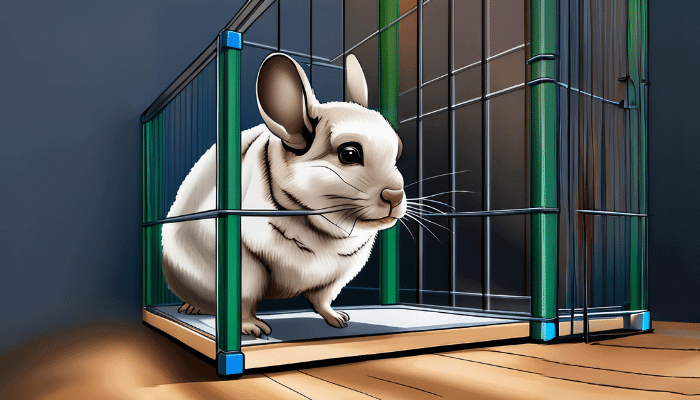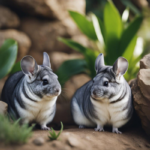Are you considering getting a chinchilla as a new furry friend? If so, providing a suitable and comfortable cage is essential for their well-being. In this comprehensive guide, we will delve into the world of chinchilla cages, exploring their features, benefits, and how to choose the perfect one for your chinchilla. From size and material to enrichment and safety, we’ll cover it all.

What is a Chinchilla Cage?
A chinchilla cage is a specialized enclosure designed to house chinchillas. It provides them with a safe and comfortable living space where they can eat, sleep, play, and exercise. These cages are specifically designed to meet the unique needs of chinchillas.
Why Do Chinchillas Need a Cage?
Chinchillas are not your typical pets; they have specific requirements that must be met to ensure their well-being. They need a cage to keep them secure, protect them from predators, and create an environment that mimics their natural habitat.
Choosing the Right Chinchilla Cage

Understanding the Importance of a Proper Chinchilla Cage Ensuring your chinchilla has a suitable cage is crucial as it serves as their primary living space. A well-designed cage provides comfort, security, and entertainment for your furry friend. Let’s explore the key factors to consider when choosing a chinchilla cage.
Size Matters: Chinchillas are highly active and agile creatures, so providing ample space is vital for their well-being. The recommended minimum cage size for one chinchilla is 24 inches by 24 inches by 24 inches. However, the larger the cage, the better! They need enough room to run, jump, and engage in their natural behaviors.
Material: When it comes to flooring, chinchillas have sensitive feet that can develop conditions like bumblefoot. While wire floors allow for proper airflow and easy cleanup, it’s crucial to provide solid platforms or bedding areas for your chinchilla to rest on. Opting for a cage with a combination of wire and solid flooring is an excellent choice.
Bar Spacing: The bars of the cage should be close enough together to prevent your chinchilla from escaping but not so close that they can get their feet stuck.
Accessibility: Choose a cage with multiple access points for easy cleaning and handling.
Vertical Space: Chinchillas love to jump and climb, so consider a multi-level cage to cater to their natural instincts.
Ventilation: Ensure the cage has adequate ventilation to maintain a healthy environment.
Easy Cleaning: Look for a cage with a removable tray or a design that facilitates cleaning.
Where Can You Find the Perfect Chinchilla Cage?
You can find chinchilla cages at pet stores, online retailers, and even from local breeders. It’s essential to do your research and read reviews to ensure you’re getting a high-quality cage.
Setting Up Your Chinchilla’s New Home
Now that you have your chinchilla cage, it’s time to set it up properly to create a comfortable and stimulating environment for your pet.
What Do You Need to Set Up a Chinchilla Cage?

Gathering the right supplies is essential for a smooth setup. Here’s what you’ll need:
Bedding: Choose appropriate bedding material such as aspen shavings or hay. Avoid cedar or pine shavings, as the oils can be harmful to chinchillas.
Hideouts: Chinchillas enjoy privacy, so provide hideouts or small houses where they can retreat.
Dust Bath: Chinchillas need a dust bath to maintain their fur. Provide a dust bath container filled with chinchilla-specific dust.
Food and Water Dispensers: Use spill-proof containers to ensure a steady supply of food and water.
Toys and Chews: Chinchillas are active and need stimulation. Include toys and chew items to keep them entertained.
Setting Up the Chinchilla Cage

Let’s go through the steps to set up your chinchilla’s new home:
Step 1: Prepare the Cage
Start by assembling the cage according to the manufacturer’s instructions. Make sure it’s stable and secure.
Step 2: Add Bedding
Spread a layer of suitable bedding on the cage’s floor. Ensure it’s thick enough to provide cushioning and absorb moisture.
Step 3: Place Hideouts and Toys
Position hideouts and toys within the cage, creating a stimulating environment. Chinchillas love to climb and explore, so include items like wooden ledges and platforms.
Step 4: Provide a Dust Bath
Set up the dust bath container in a corner of the cage. Chinchillas will use this to groom themselves.
Step 5: Food and Water Dispensers
Attach food and water dispensers to the cage. Ensure they are secure and easily accessible for your chinchilla.
Step 6: Monitor the Temperature
Chinchillas are sensitive to temperature. Ensure the room is kept between 60-70°F (15-24°C) to keep your pet comfortable.
Social Needs: Accommodating a Chinchilla Friend

Chinchillas are social animals, and they thrive in the company of their own kind. Consider housing multiple chinchillas together if space allows. A larger cage with multiple levels and separate sleeping areas will ensure that your chinchillas can coexist harmoniously while maintaining their individual territories.
Enrichment and Environmental Stimulation for Happy Chinchillas
Chinchillas are intelligent creatures that require mental stimulation and environmental enrichment. Look for a cage that offers multiple levels, platforms, and accessories for them to explore, climb, and play. Adding tunnels, hammocks, and chew toys will keep your chinchilla entertained and prevent boredom.
Our Favorite Chinchilla Cage:
MidWest Homes for Pets Deluxe Critter Nation Double Unit After thorough research, we have found the MidWest Homes for Pets Deluxe Critter Nation Double Unit to be the top choice for chinchilla owners. This cage features durable construction, ample space, secure doors, and a convenient storage shelf. It provides everything your chinchilla needs to thrive.
Conclusion
Your chinchilla’s happiness and well-being depend on the quality of their cage and how you set it up. By choosing the right chinchilla cage and creating a stimulating environment, you’ll provide your furry friend with a safe and comfortable home.
Remember to monitor their cage, keep it clean, and interact with them regularly. With the right care, your chinchilla will thrive in their new habitat, bringing joy and companionship to your life.
For more information on chinchillas and their care, you can visit reputable sources like [Wikipedia] to deepen your knowledge.
Common FAQs About Chinchilla Cages

What’s the Best Location for the Chinchilla Cage?
The ideal location is a quiet, well-ventilated room away from direct sunlight and drafts. Chinchillas prefer a consistent environment.
Can I Use a Hamster Cage for a Chinchilla?
No, hamster cages are typically too small for chinchillas. Chinchillas require more space to jump and climb. Use a cage specifically designed for chinchillas.
Are Wire Floors Safe for Chinchillas?
Wire floors can cause foot problems for chinchillas. It’s best to provide solid flooring with appropriate bedding to prevent injuries.
Can I Use a Glass Tank as a Chinchilla Cage?
While glass tanks can be used, wire cages are generally preferred for their ventilation. If using a glass tank, ensure proper ventilation and cleanliness.
Can Chinchillas Share a Cage?
Chinchillas are social animals and can usually live together if they are introduced properly and have enough space. However, some chinchillas may be territorial and prefer to live alone.
How High Should the Cage Be?
Chinchilla cages should be tall enough to allow them to jump and climb. A height of at least 24 inches is recommended.
Can I Build My Own Chinchilla Cage?
Yes, you can build a custom chinchilla cage, but it must meet the criteria for size, materials, and safety. Make sure it’s escape-proof and easy to clean.
Can Chinchillas Be Kept Outdoors in Their Cage?
Chinchillas are sensitive to temperature extremes, so outdoor housing is not recommended. They thrive indoors, where you can control the environment.











5 thoughts on “Chinchilla Cage Essentials: Choosing the Right Home”